Cessna after Bend
Published 5:00 am Sunday, October 4, 2009

- One planes evolutionCessna once produced two piston-powered propeller planes at its Bend plant, each made from lightweight composite material. Pictured above, workers put together the Columbia 350 in 2003, when it was still a Columbia Aircraft plant. Cessna bought Columbia out of bankruptcy in 2007. Now, as part of its renamed line of aircraft, this Cessna plane is known as the Corvalis 350, left. The other in the line is the Corvalis 400. Photo courtesy Cessna
When Cessna Aircraft took over Columbia and its line of high-performance aircraft two years ago, officials knew they had to make some changes.
After all, Columbia Aircraft Manufacturing Co. had gone bankrupt using the methods it had in place.
But until the aviation industry took a deep dive in the economic downturn, they hadn’t intended to close Cessna’s Bend operations, where Columbia was based.
Now, the Bend plant has been shuttered and work on the planes — renamed the Corvalis 350 and Corvalis 400 — is moving to Cessna plants in Independence, Kan., and Chihuahua, Mexico.
In Independence, workers have set up temporary space to assemble the planes inside its paint facility. Production will begin there Tuesday, officials said.
In the meantime, they’re preparing space for a permanent Corvalis line along the back part of the brightly lit factory where workers assemble the Citation Mustang business jet and Cessna’s line of single-engine 172, 182 and 206 aircraft.
The permanent line will be running by the first of the year, Rod Holter said over coffee at the plant last month.
Holter is Cessna’s vice president of Mustang and single-engine piston products and outlying operations.
Independence workers will perform the airframe finishing on the Corvalis, install the systems, avionics, engines and interiors, paint the aircraft, and flight-test and deliver it.
In Mexico, workers will build its composite airframe and wings.
Division of the work was based on the strengths of each site, Holter said.
For the first four to six months, the Corvalis line in Independence will move at an easy pace, he said.
“It will be very slow, very methodical,” Holter said.
In the beginning, it will take about six months to build a plane. That will accelerate in April.
Full production will begin later in 2011.
To help with the move, the Bend facility built up a safety stock of inventory to help get it through the transition.
Cessna also hired 30 workers from Bend to work in Independence. Each had experience on a different critical process, Holter said. They include engineers, painters, production workers and purchasers.
Matt Lynn, 27, moved to Independence last month. He works on the flight line and said the decision to move was easy. He’s worked on that aircraft for nearly six years.
“I wanted to stick with it,” Lynn said, while taking a break from making adjustments on a Corvalis that will be used as a trainer.
Cessna took over the Columbia Aircraft plant in late 2007 after it successfully bid $26.4 million for the assets. At the time, Columbia employed more than 400 people.
The addition of a high-performance line of aircraft broadened Cessna’s product line. It also gave Cessna expertise in composite manufacturing.
Holter had moved to Bend to head up the plant after the acquisition.
Cessna had intended to expand there. Then the economy took a downturn and sales dropped.
In February, Holter told Cessna chairman and CEO Jack Pelton that the business model there wasn’t working.
“We need to do something,” he said he told Pelton. The plant wasn’t building enough airplanes to continue operation.
The move was approved in May. Since then, “we’ve been going 100 miles an hour,” Holter said.
In the first six months of 2009, Cessna delivered 24 Corvalis aircraft. That’s down nearly half from the 46 delivered during the same time last year.
Production of 172, 182 and 206 aircraft also has fallen during the downturn.
This year, Cessna expects to deliver more than 400 single-engine airplanes, including the Corvalis. That’s down from 733 single-engine planes delivered in 2008.
Demand is beginning to return, Holter said.
“We’re seeing some movement,” he said.
Unsold Corvalis aircraft are nearly wiped out. Four sit inside a hangar in Independence. Some of those are spoken for, Holter said.
Demand for the Mustang has held up. The company expects to deliver 125 of the light jets this year, up from 101 a year ago.
In the meantime, Cessna’s Independence plant is ready for the future.
As it makes space to take on the Corvalis, it’s also opening up floor space to take on other Cessna products, Holter said.
“We’re ready to go when the economy picks up,” he said.






